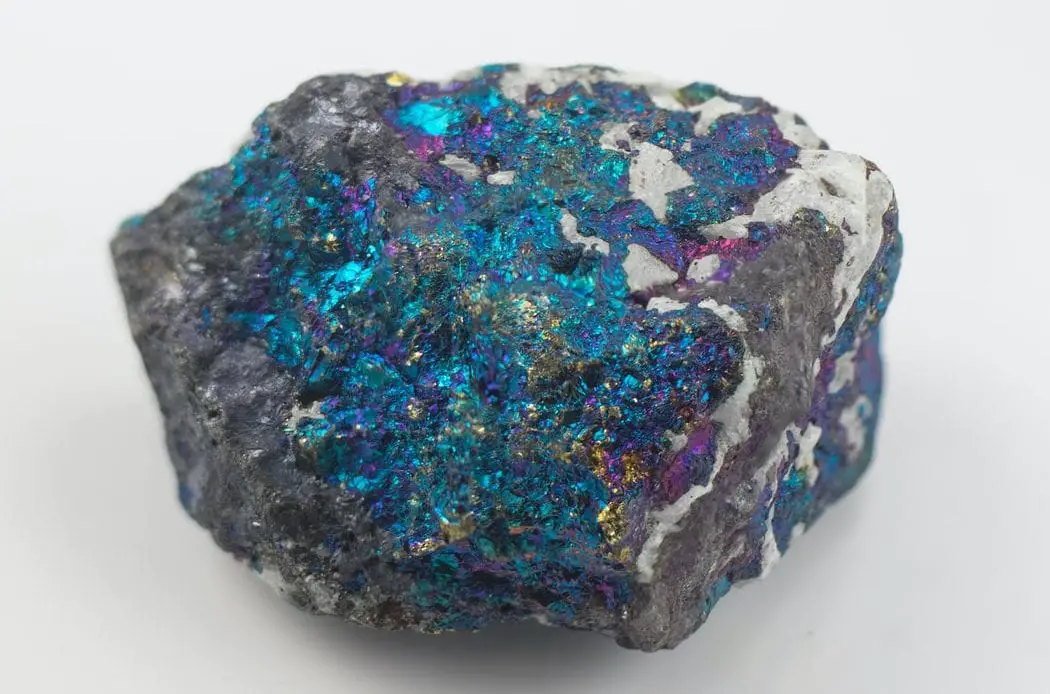
Lapis, the stone
Lapis lazuli is a rich blue semi-precious gemstone, sourced from metamorphic rock. The stone is opaque in nature. It has been valued since time immemorial and people in different cultures use it extensively. In many civilizations, lapis lazuli has spiritual value. It is known to be a charm for good luck. Referring to it casually as just “lapis”, it is a blue stone with gold and white flecks. The mottled gold flecks on it are composed of pyrite, while the white spots come from calcite. Depending on the source of the rock, it may be a lighter shade of blue. It is a singularly beautiful stone, even in its rough state. The rock is made from a number of minerals, mainly lazurite.
The answer of the question, what is the spiritual meaning of lapis lazuli goes back to the 7th millennium BCE. During this initial phase of its manufacture, it was mined in Afghanistan. In Bhirrana, now in India’s state of Haryana, artifacts of lapis lazuli have been found. They date back to 7570 BCE. Bhirrana is the oldest site of the Indus Valley Civilization.
An ancient stone
Lapis has been on our planet for a very long time. It is no wonder that great cultures have traditions based on the spiritual meaning of lapis lazuli. Beads fashioned out of the rock have been discovered at Neolithic burial sites. Found at Mehrgarh, now Pakistan, the Caucasus, and Mauritania, this is clearly an indication that it was used in the spiritual and religious domain.
The stone’s deep blue hue has a celestial quality and has always been a symbol of royalty, honor, power and divinity. It is a stone that stands for spirit and wisdom. The fact of its color, blue, makes it a charm for truth and wisdom. The color is often a subject of wonder for onlookers. It is also famous for the amazing ultramarine pigment that is made from it. The lighter shade of the stone is colloquially called “denim lapis”.
Tutenkhamen
If you want to know what is the spiritual meaning of lapis lazuli, you should note that it played a huge role in Ancient Egyptian Civilization and culture. This was around 4000 B.C. It was in the breastplate of the High Priest of Egypt. In the Bible’s Old Testament, it was referred to as a sapphire as there was a lack of knowledge of the name. Compared to the arid land of Egypt, this stone was a magical find and people meditated to it, thinking it had spiritual power. Royal subjects took pride in wearing clothes encrusted with lapis lazuli. They also had their clothes dyed in the rich blue color. This transformed their status to those of the gods.
The golden sarcophagus of the great pharaoh, Tutankhamen, was inlaid with a rich array of lapis. Other burial ornaments, like scarabs, were also emblazoned with the coveted stone. Kings and Queens of Egypt vied for its attention in their crowns and jewelry. The gold and orange dessert hues took a backseat as this deep cobalt blue stone was cherished. People thought that lapis lazuli had spirituality in it because of the gold specks inherent. Priests and nobles compared the look of the stone to the night sky with stars shining. People believed that lapis was a synonym for the Divine cosmos.
Ancient Persia and world cultures
In Ancient Persia, spiritual lapis lazuli was the symbol of something powerful and a force to contend with. It was compared with stars and the planets as having spiritual relevance. In pre-Columbian America, too, the blue stone was invaluable as a source of the cosmos, with divinity attached to it. In the old cultures of Islam, along with turquoise, lapis was, and still is, a stone to protect people from the “evil eye”. The Ancient Greeks and Ancient Romans took the stone to their hearts as ornaments.
Medieval Europe
In the Middle Ages, lapis lazuli, comparable with the blue color of the heavens, was thought to thwart evil spirits. When people were believed to be “possessed“ by the wiles of evil, lapis would “assure” a way out of the darkness. It was said to imbue the spiritual qualities of wisdom and light. When it was crushed into a powder, and then processed for use, it produced a pigment so blue, it amazed painters.
What is the spiritual meaning of lapis lazuli in terms of art? Well, Michelangelo was struck by the intense ultramarine color, though it was expensive to produce. He has used it for the background of the ceiling of the Sistine Chapel fresco. You can see the vibrancy of the color to this day. In both the paintings of the fresco, The Last Judgement and The Creation of Adam, you can see the effect of the ultramarine background. It was thought to be a color depicting the heavens, a place of God, holy and pious. Here, too, lapis lazuli takes on a spiritual meaning.
During the Renaissance, Queen Catharine the Great decorated entire palace rooms with the pigment and the stone itself. She had them embedded in fireplaces, doors, mirror frames, and vases.
Buddhism
As a color, blue appears in many religions as an emblem of heaven, gods, spirituality and eternal faith. Blue is symbolic of truth and calm, with a soothing coolness about it. It’s the color of peace. In Buddhism, both light and dark aspects of the color are important. As lapis lazuli has both dark stones and light, Buddhists believe that lapis is spiritual in nature. In the everyday existence of the spiritual Buddhist, lapis lazuli is a powerful stone that commands holy respect. Many sculptures of the Buddha are rendered in this stone.
Buddhism reveres this stone as symbolic of the sea and sky. Buddhists see the sky as a limitless entity, as infinity itself. This has implications for devout Buddhists reaching ascension, or reaching heights. The effect of this is being closer to God, or in this case, the Buddha. As opaque as the earth itself is, so is the lapis lazuli stone. Still, it has in itself power and energy to lift the spirit to soaring heights. In this way, it helps humans attain peace and happiness by exposing them to the wisdom of both the earth and sky.
In the way of Buddhism, the “Blue Buddha”, often portrayed in the pigment of lapis lazuli, is known as the representation of the Buddha of Healing.

Chinese and Tibetan belief
Chinese people, even now, are among some Far Eastern peoples who admire lapis lazuli tremendously. They have carved artifacts out of it, and these adorn their temples and ancient structures. Many Chinese are Buddhist, so perhaps, what is the spiritual meaning of lapis lazuli to them is for the reason they believe in the Buddha. Many Asian communities, such as those from the kingdom of Nepal, also believe in the spiritual benefits of lapis lazuli.
Tibetans are also Buddhists and come from a long and old Buddhist tradition of faith. They valued lapis lazuli as more treasured than gold, and not just for ornament. Old Tibetan legend has it that sages saw the reflection of the night sky in lapis lazuli. Tibetans also say that the hair of one of their most revered goddesses was the color of lapis. Both men and women wore lapis ornaments on their heads to show their unbounded devotion to this goddess.
Spiritual mysticism
In answer to the question, what is the spiritual value of lapis lazuli in today’s world, we just need to research more. Lately, lapis lazuli, has been acknowledged by some people, as being more valuable than a diamond. A sense of mystery relates to the stone. Perhaps this is due to where the stone comes from. The mines from where the stone is sourced, are located in the very distant regions of Afghanistan. These are in areas that are very inaccessible, behind the Hindu Kush range.
Tradition has it that this astounding stone stood for all that was rare, and as a result, pure. Even now, it is said to have miraculous curative features. Those who wear it swear that it gives strength. It shines with an aura of a high degree of polished cleanliness. In the field of alternate medicine, it is used for its healing of inflammation or internal bleeding. Those suffering from anxiety find great relief from spiritual lapis lazuli.
The mysticism of lapis lazuli lies in the fact that those who wear it, or are exposed to its positive aura, will undoubtedly reach enlightenment. The spiritual belief in the stone and those who follow its sentiments, state that upon wearing it, all negativity fades.
Value in the present day
Faithful disciples of the spiritual value of lapis exist today. In fact, more and more people are seeking spirituality, either to take them far from materialism, or to find peace. Today, executives, and people working in corporate fields find that their faith in the stone helps them stay calm. They claim that lapis lazuli has spirituality and is related to creativity, productivity and intellectual reasoning. They have apparently found the solution to all their questions and to the main question, what is the spiritual meaning of lapis lazuli. Lapis lazuli is spiritual in lifting the mind to higher thoughts and knowledge. This aids in learning processes and enhances memory. Lapis lazuli encourages honesty in spirit as well as in overt behavior. It is the stone that makes you true to yourself and helps in communicating effectively. As a result, good inter-personal relationships are maintained. This leads to harmony with yourself and others. If you want the answer to the question, what is the spiritual meaning of lapis lazuli, maybe you should start wearing this very positive, enriching stone.

